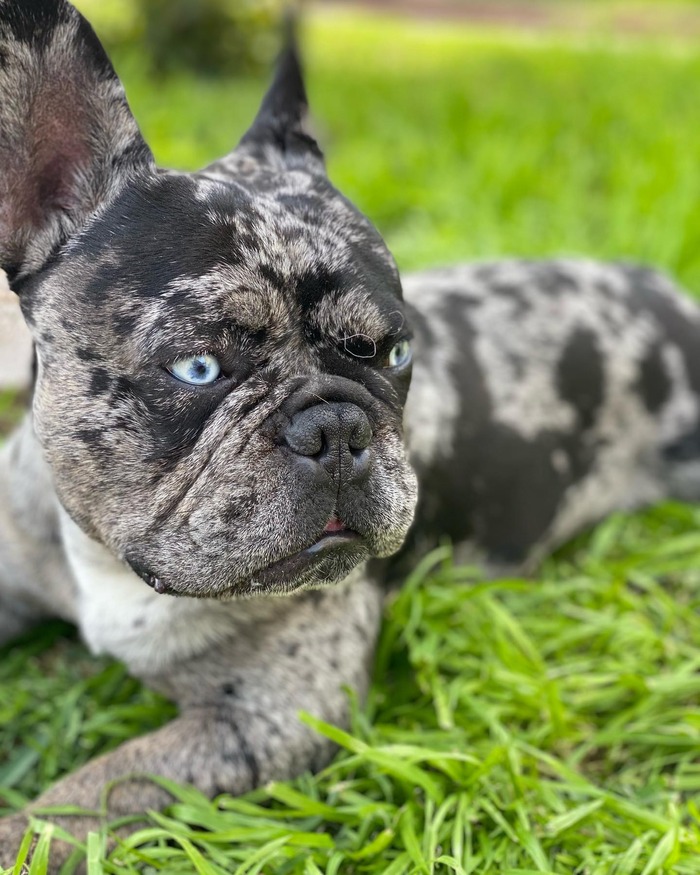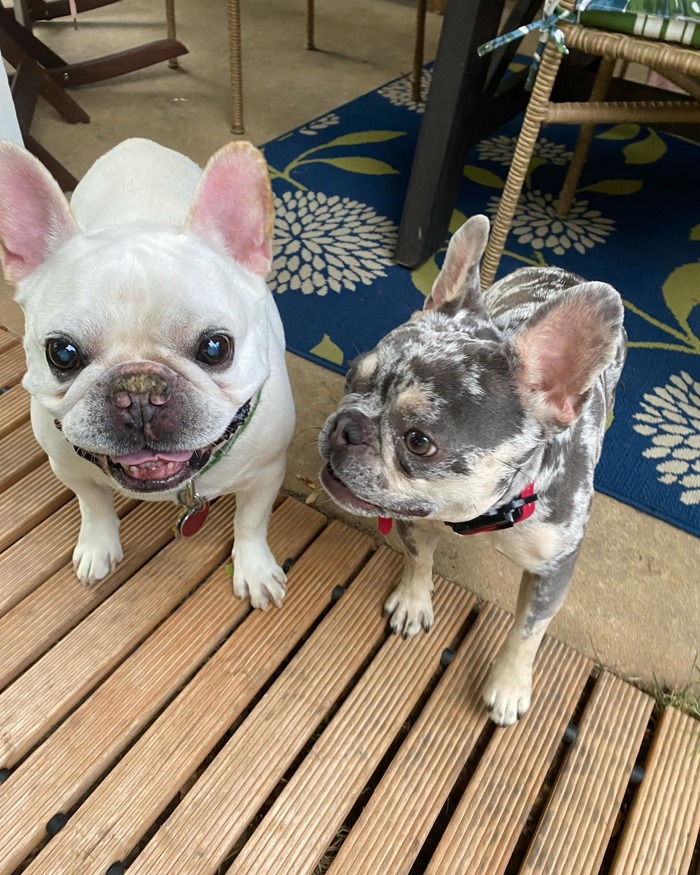Blue-eyed Frenchies have become increasingly popular over the past few years as people seek to add a unique flair to their beloved pets. This article aims to cover all aspects of these stunning animals, from their history and characteristics to the health risks associated with owning one. By reading this article, you will gain a comprehensive understanding of blue-eyed Frenchies and feel confident in your decision to determine if they are the right fit for you and your family.
French bulldogs, or “Frenchie” as they are affectionately known, have become one of the most popular small dog breeds in recent years—and no wonder! With their distinctive bat-like ears and pushed-in faces, they always turn heads. In addition to their unique and cute looks, these highly intelligent pups form strong bonds with their owners and can bring happiness and love into any home.
Explanation of the popularity of blue-eyed Frenchies

One factor that makes French bulldogs even more attractive than usual is their striking range of eye colors—and those who have bright blue eyes set against a black or deep brown coat usually draw the most attention. The rarity of such a combination, the sparkle of their big round eyes and the exotic allure are what have made blue-eyed Frenchies increasingly popular in recent years.
French Bulldogs: History and Characteristics

In terms of ancestors, french bulldogs originated in England in the 1800s as a result of crossbreeding between English bulldogs and terrier breeds from France—in particular, ratters descended from dogs used for fighting.
Despite their fascinating history, french bulldogs are now bred purely for companionship and make great family pets as they’re generally good-natured, loyal, loving and often clumsy in the most adorable way! They can range from 25 to 33 pounds with a life span of 11 to 13 years. The most important physical features—apart from those much-fabled bat ears–are the broad chest, prominent cheeks and very broad shoulders that give a French Bulldog its unique breed look.
French Bulldog Eye Colors

When it comes to eye color, the range of hues in French Bulldogs is usually brown (anything from light tan through to deep chocolate) but can also be blue—which is what makes them so appealing! In fact, if two Frenchies with blue eyes are bred together, their puppies may even have an unusual greyish hue to their peepers called “ghost eye” that only they can have.
Are French Bulldogs Born with Blue Eyes?

There is an old myth that French Bulldogs are born with blue eyes, but this is not actually correct — in fact, it’s the opposite! All Frenchie puppies will come into the world with brown eyes and then change color during their first few weeks of life until about eight to twelve weeks when their adult-colored coat has developed and sets permanently (although some lightening can still continue thereafter).
Difference Between Brown-eyed and Blue-eyed Frenchies

The difference between brown-eyed Frenchies and blue – often referred to as “fairy tale” colored due to their unique look – is not just the eye color but also their coat (pigment) which has mutations that are linked to its lighter shade. Not all French Bulldogs have stunning blue peepers, and nor do all dogs with this color of coat have blue eyes. In addition, there is a slight genetic variance in the way each pepper carries its colored gene, which can affect whether its eyes turn brown or blue (or even multiple colors).
Blue-eyed Frenchies: Coat Color

As mentioned above, those lovely blue-eyed Frenchies usually come with slightly paler fur than normal compared to other members of the breed due to its pigmentation gene, and so unsurprisingly, that means their coat will actually be a very different color from a regular french bulldog. Shades of grey, silvers and creams are more common in those with blue eyes, while they’re also likely to have some white patches distributed amongst the lighter hues.
How Do French Bulldogs Have Blue Eyes?

It all comes down to genetics! French Bulldog parents can pass on two alleles (genetic factors) to their puppies, which can affect the coat color and their eye color. For example, if both parents (each of whom must have at least one blue-eyed parent themselves to be able to pass it on) carry a single gray gene each, then the puppy will inherit its lighter shade from these two genes—but also may develop double blue eyes instead of brown!
Health Risks Associated with Blue-eyed Frenchies

Blue Eyes in French Bulldogs may be rare and undeniably charming, but we need to point out that there is a slightly increased risk of health problems in those with this gene. For example, the pigment mutation that leads to these eye colors has also been linked to vision impairments such as progressive retinal atrophy (PRA) which can lead to degenerative blindness and conditions like cataracts; – meaning any pup should have regular checkups from an experienced vet who knows about inherited diseases specific to the breed.
Heterochromia in Frenchies

As we mentioned before, French Bulldogs can also come with two differently colored eyes; usually referred to as “heterochromia” or even sometimes referred to being called a “pirate-eyed Frenchie,” which is much less medical term but still aptly descriptive of this condition as it children are born with distinctive colors in different peepers. It’s also linked to genetic transmission from the parents.
Temperament and Personality of Blue-eyed Frenchies

Despite any potential health concerns, blue-eyed Frenchies have wonderful personalities and temperaments that most owners are sure to find endearing—which is part of why they’ve become so popular! As with all pups, those with lighter-hued eyes need regular socialization to help build their confidence in new environments or around people, but aside from that, you can expect them to be generally placid and loyal, lovable little cuddle companions who love the interaction with all the family members.
How to Train a Blue-eyed Frenchie Puppy
As with any pup, blue-eyed Frenchies will benefit greatly from consistent yet gentle training when they’re young pups in order to ensure they grow up happy being around people and other animals. This doesn’t have to be complicated either- simply combine positive reinforcement with patience, lots of treats and rewards along the way so that it can start feeling confident in tackling new things.

Possible Problems with French Bulldogs With Blue Eyes
While most blue-eyed Frenchies are healthy as long they’re looked after properly, we should also keep in mind some potential problems associated with them—such as more frequent eye infections due to their large eyes not being able to close properly. Additionally, their eyes can be more prone to injury due to their higher sensitivity and should be monitored for any signs or discomfort.
Conclusion

Blue-eyed Frenchies offer everything you’d expect from any Frenchie plus a charm that makes them even more special–which is why they have become so popular lately! That being said, it’s important not to forget about the potential health problems associated with blue eye color and make sure your pup is healthy and looked after properly. We advise all potential owners to always do their research beforehand, speak with an experienced veterinarian that knows the breed well and understand what blue-eyed Frenchies may bring before taking a pup home.
In short, blue-eyed Frenchies are an attractive, endearing and unique pet that is sure to put a smile on your face every day. With the right care, they can make a wonderful addition to any family!
